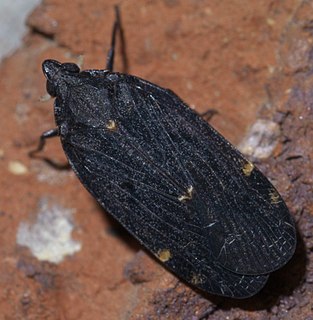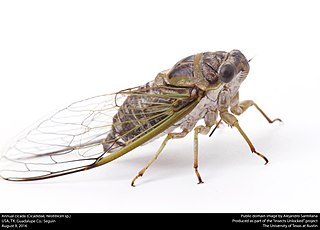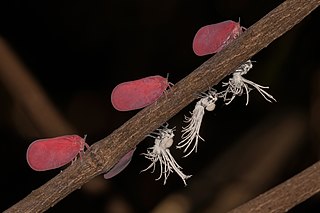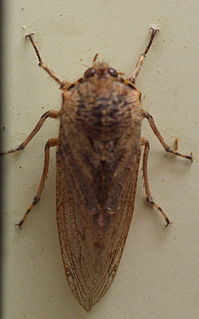 W
WAcanaloniidae is a family of planthoppers. It is sometimes treated as a subfamily of Issidae.
 W
WAchilidae is a family of achilid planthoppers in the order Hemiptera. There are at least 160 genera and 520 described species in Achilidae.
 W
WAetalionidae are a family of treehoppers in the superfamily Membracoidea. Aetalionidae are somewhat like Membracidae in that they have one to three rows of short spines on the hind tibia but differ in having the front femur fused to the trochanter and the scutellum is completely exposed. The females have finger-like protrusions on the genital capsule. The family is mostly Neotropical. The subfamily Biturritiinae is Neotropical while the subfamily Aetalioninae has a Neotropical genus Aetalion and the sole Old World representative genus Darthula with a single species Darthula hardwickii.
 W
WThe Aphrophoridae or spittlebugs are a family of insects belonging to the order Hemiptera. There are at least 160 genera and 990 described species in Aphrophoridae.
 W
WCaliscelidae is a family of planthoppers, sap-sucking insects that belong to the order Hemiptera, suborder Auchenorrhyncha and superfamily Fulgoroidea. They are somewhat anomalous and have often been included within the family Issidae. Studies made in 2013 of the phylogeny of the Issidae and other groups using molecular techniques support the treatment of the group as a separate family. Sexual dimorphism can be marked. Some members of the family are called piglet bugs due to the shape of their snout. A particularly aberrant genus described in 2011 from India, Formiscurra, has males that resemble ants.
 W
WCercopidae are the largest family of Cercopoidea, a xylem-feeding insect group, commonly called froghoppers or spittlebugs. They belong to the hemipteran suborder Auchenorrhyncha.
 W
WA leafhopper is the common name for any species from the family Cicadellidae. These minute insects, colloquially known as hoppers, are plant feeders that suck plant sap from grass, shrubs, or trees. Their hind legs are modified for jumping, and are covered with hairs that facilitate the spreading of a secretion over their bodies that acts as a water repellent and carrier of pheromones. They undergo a partial metamorphosis, and have various host associations, varying from very generalized to very specific. Some species have a cosmopolitan distribution, or occur throughout the temperate and tropical regions. Some are pests or vectors of plant viruses and phytoplasmas. The family is distributed all over the world, and constitutes the second-largest hemipteran family, with at least 20,000 described species.
 W
WCicadidae is the largest family of cicadas, with more than 3,200 species worldwide. The oldest known definitive fossils are from the Paleocene, a nymph from the Cretaceous Burmese amber has been attributed to the family, but could also belong to the Tettigarctidae.
 W
WThe Cixiidae are a family of fulgoroid insects, one of many families commonly known as planthoppers, distributed worldwide and comprising more than 2,000 species from over 150 genera. The genera are placed into three subfamilies, Borystheninae, Bothriocerinae and Cixiinae with sixteen tribes currently accepted in Cixiinae.
 W
WClastopteridae is a family of spittlebugs in the order Hemiptera. There are at least 10 genera and 100 described species in Clastopteridae.
 W
WDelphacidae is a family of planthoppers containing about 2000 species, distributed worldwide. Delphacids are separated from other "hoppers" by the prominent spur on the tibia of the hindleg.
 W
WDerbidae is a family of insects in the order Hemiptera, the true bugs. It is one of the largest and most diverse families of planthoppers. It is widely distributed around the world, especially in the tropics, and with many species in subtropical and temperate regions.
 W
WDictyopharidae is a family of bugs in the suborder Auchenorrhyncha belonging to the infraorder Fulgoromorpha. The family comprises nearly 760 species in more than 150 genera which are grouped into two subfamilies, Dictyopharinae and Orgeriinae.
 W
WEurybrachidae is a small family of planthoppers with species occurring in parts of Asia, Australia and Africa. They are remarkable for the sophistication of their automimicry.
 W
WFlatidae are a family of fulgoroid planthoppers. They are cosmopolitan in distribution and are distinguished from others in the superfamily by a combination of characters. Like all other planthoppers, they suck phloem sap of plants. Some species are known to communicate with vibrations through the plant stems. Communication may be with mates, or with ants that tend the nymphs, protecting them and gathering honeydew secretions. Adults of some species have brightly coloured forewings which are tougher and known as tegmina unlike the membranous hindwings which are used for flight. Although a few can be identified by their coloration, most species requires dissection and examination under a microscope with access to literature on already described species.
 W
WThe family Fulgoridae is a large group of hemipteran insects, especially abundant and diverse in the tropics, containing over 125 genera worldwide. They are mostly of moderate to large size, many with a superficial resemblance to Lepidoptera due to their brilliant and varied coloration. Various genera and species are sometimes referred to as lanternflies or lanthorn flies, though they do not emit light.
 W
WIssidae is a family of planthoppers described by Spinola in 1839, belonging to the order Hemiptera, suborder Auchenorrhyncha superfamily Fulgoroidea.
 W
WKinnaridae is a family of fulgoroid planthoppers. This is a small family with a little more than 20 genera and about a 100 species. The family was erected by Muir in 1925 and most members are found in the Oriental and Neotropical regions and only a few in the Nearctic and Palaearctic regions.
 W
WLophopidae is a family of fulgoroid plant-hoppers with most species found in tropical South America and Asia. Most members of the family are characterized by the face being longer than wide with at least two lateral ridges. The hind tibia can bear some spines, two to three. Lateral ocelli are present below the compound eye and slightly in front of it. The wings are broad and held somewhat flat and the wings are often patterned. The nymphs have two long tails and many members have slightly flattened front tibiae.
 W
WMachaerotidae are a family of bugs in the superfamily Cercopoidea which were formerly grouped with the other cercopids. They are sometimes called as tube-forming spittle-bugs as the nymphs form a calcareous tube within which they live. These bugs are mainly found in the Old World tropics. The adults of many genera have a long, free and spine-like process originating at the scutellum and thus superficially similar to the tree-hoppers, Membracidae. Its tegmen or forewing, like typical bugs of the suborder Heteroptera, always has a distinct, membranous apical area.
 W
WMeenoplidae is a family of fulgoromorph planthoppers that are closely related to the Kinnaridae. They are small, with tent-like wings and usually are less than a centimetre long and a little more than a 100 species in around 25 genera are known with a distribution restricted to the Old World. They are distinguished by having one or more of their claval veins covered in sensory pits along their length. The face is usually broad and the lateral carinae are strongly elevated. The last segment of the labium is elongate. A median ocellus is usually present. The wings are always present in adults and the venation consists of a small number of veins and very few cross veins. There are two subfamilies currently considered valid Meenoplinae and Kermesiinae. About 50 species are known from Africa. Along with the Achilixiidae and Kinnaridae, they have flattened star-shaped plate organs on their antennae. The nymphs are found close to the soil while adults feed mainly on monocots. Species identity can usually be established reliably only by examination of the male genitalia. A few species Phaconeura pluto, Meenoplus cancavus, Tsingya clarkei, and Suva oloimoa are known to be cave dwelling.
 W
WTreehoppers and thorn bugs are members of the family Membracidae, a group of insects related to the cicadas and the leafhoppers. About 3,200 species of treehoppers in over 400 genera are known. They are found on all continents except Antarctica; only five species are known from Europe. Individual treehoppers usually live for only a few months.
 W
WNogodinidae is a family of planthoppers. They have membranous wings with delicate venation and can be confused with members of other Fulgoroid families such as the Issidae and Tropiduchidae. Some authors treat it as a subfamily of the Issidae. Some of their key features are a frons ("face") that is longer than wide and a reticulate wing venation. They are less than 2 cm long. The antenna arises well below the eye, has the base clubbed and flagellum unsegmented. The lateral ocelli are outside the margins of the face. The face has carinae on the edge. On the hind leg, the second tarsal segment has an apical spine arising from it. The tibia of the hind leg also has spines towards the tip. An important family character is found in the shape of the male genital structure, a style that is longer than broad. Most members of this family are forest species.
 W
WRicaniidae is a family of planthopper insects, containing over 40 genera and 400 species worldwide. The highest diversity is in tropical Africa and Asia and in Australia, with a few species occurring in the Palearctic. It is one of the smaller families in the planthopper superfamily Fulgoroidea.
 W
WThe Tettigarctidae, known as the hairy cicadas, are a small relict family of primitive cicadas. Along with more than 20 extinct genera, Tettigarctidae contains a single extant genus, Tettigarcta, with two extant species, one from southern Australia and one from the island of Tasmania. Fossil taxa include Paratettigarcta from the Miocene of New Zealand, Meuniera from the Paleocene of France, and Sanmai from the Late Jurassic of China, and Maculaferrum of early Late Cretaceous Canada.Tettigarcta are the closest living relatives of the true cicadas.
 W
WThe Tettigometridae are a family of Fulgoromorpha (planthoppers), with a species distribution from: Europe, Africa, Asia through to west Malesia.
 W
WTropiduchidae is a family of planthoppers in the order Hemiptera. There are at least 160 genera and 600 described species in Tropiduchidae.